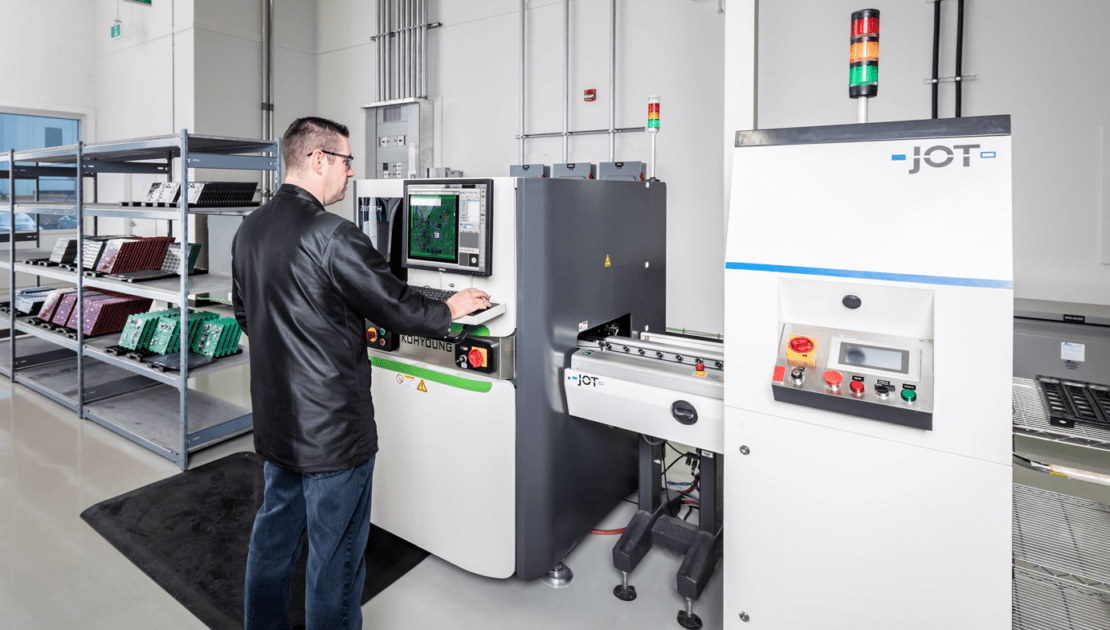The Importance of Automated Optical Inspection for PCB Assembly

The Printed Circuit Board (PCB) is the central processing unit of your electronics product and is therefore crucial to its effective functioning. With technological advances, PCBs are getting smaller, more compact and sophisticated. The introduction of Surface Mount Technology (SMT) enabled the average board to have thousands of soldered joints – which is where most problems occur.
This makes rigorous manual inspection impractical. Technicians would have to examine in detail each component, marking, and solder joint on a board — increasing the risk of missing numerous imperfections.
There is also pressure from the marketplace which demands high-volume runs of high-quality products manufactured and delivered to the market in increasingly shorter time frames. Original Equipment Manufacturers (OEMs) need inspection and testing methods that are reliable to ensure product quality, yet fast enough to not slow down the production process.
This is where an Automated Optical Inspection (AOI) comes in.
In simple terms, AOI may be thought of as a visual examination of a printed circuit board (PCB) assembly. The process conducts a detailed scan of the board with a high-resolution camera to identify missing or skewed components, quality defects, short circuits and solder joint defects. It uses infrared, LED, ultraviolet, and fluorescent illumination to capture multiple images. These images are used to create a “golden” standard for a PCB after successful assembly.
During subsequent production runs, the AOI equipment scans and compares the new images compared against the established gold standard for that assembly to flag any potential defects. Technicians would then examine these areas in a close-up view and determine next steps to rectify the defective areas.
Your Electronics Manufacturing Services (EMS) provider should ideally have AOI built into their PCB production process.
Benefits of AOI
AOI indicates process problems in bare boards, solder paste application, and assembly in the beginning phase, and offers feedback which can be used to formulate a rapid response to address them.
Catching defects early on in the manufacturing process reduces the costs of correction later on and helps to avoid the issue from reoccurring during a large-scale production run, which could end up being expensive and time consuming.
The AOI process delivers real-time inspection and resultant data that allows for better process and quality control, as well as rectification of any potential problems. Its algorithms can track and document good and defective PCB assemblies. So, efficiency is enhanced from the standpoints of process-management, operational integrity, and documentation.
Much of the equipment used in AOI is tunable, which allows Contract Electronics Manufacturers (CEMs) to filter acceptable issues while catching defects that would have been missed during a physical visual review.
Considerations for AOI
While AOI offers several benefits, there are certain points to keep in mind while evaluating your prospective CEM partner’s application of the technology.
Pass Rates vs. Parameters
A higher AOI pass rate offers support to the argument that a manufactured product is likely to be more reliable in its operation. However, a higher pass rate is not always an indication of guaranteed performance of your product.
Conversely, a lower pass rate does not imply poor build quality; it may be an indicator of the standards specified and put in place by your EMS provider.
What is of interest to you as an Original Equipment Manufacturer is a high-performing finished product, not necessarily a high pass rate.
A rational approach would be to ask your EMS partner for the inspection parameters, since the automated system merely responds to instructions set by the operator. The AOI machine will only examine what it is asked to, and it will not examine what it is not asked to. Utilizing AOI or a series of inspection stages during production will ensure repeatable and consistent output.
Blending Automation with Manual Inspection
While there is a tempting tendency to view technology as the infallible solution to all manufacturing issues, we must recognize the value of manual inspections. For example, when examining the quality of a solder joint, adding a level of manual inspection to AOI will yield better results. When checking hidden solder joints in certain assemblies, an X-ray can also be a useful inspection method.
The August Partnership
AOI plays an important role in ensuring defect-free quality and in the precision of your finished electronics products. It offers a shorter timeline, increased efficiency, and reduced costs that would have accrued if reworking were necessary.
At August, we have an uncompromising commitment to quality and integrity of production processes. FRind out more about our inspection and testing capabilities.
We hope this blog post gave insights into why you should consider AOI when evaluating your prospective CEM partner. If you have additional questions regarding AOI and its benefits, or if you just want to chat, we are here to help. Contact us today.
